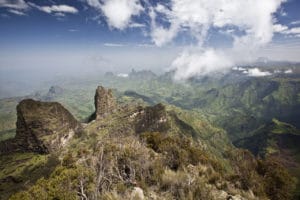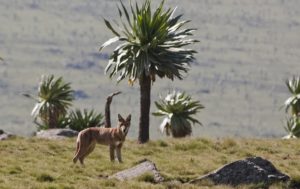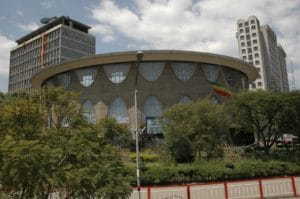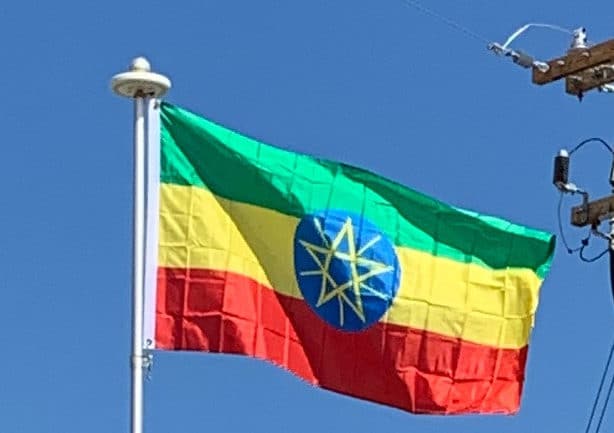
The major portion of Ethiopia lies in the Horn of Africa, which is the easternmost part of the African landmass. The territories that have frontiers with Ethiopia are Eritrea to the north and then, moving in a clockwise direction, Djibouti, the de-facto state of Somaliland, Somalia, Kenya, South Sudan and Sudan. Within Ethiopia is a vast highland complex of mountains and dissected plateaus divided by the Great Rift Valley, which runs generally southwest to northeast and is surrounded by lowlands, steppes, or semi-desert. There is a great diversity of terrain with wide variations in climate, soils, natural vegetation and settlement patterns.

Ethiopia is an ecologically diverse country, ranging from the deserts along the eastern border to the tropical forests in the south to extensive Afromontane in the northern and southwestern parts. Lake Tana in the north is the source of the Blue Nile. It also has many endemic species, notably the gelada, the walia ibex and the Ethiopian wolf (“Simien fox”). The wide range of altitude has given the country a variety of ecologically distinct areas, and this has helped to encourage the evolution of endemic species in ecological isolation.
Economy:
According to the IMF, Ethiopia was one of the fastest growing economies in the world, registering over 10% economic growth from 2004 through 2009. It was the fastest-growing non-oil-dependent African economy in the years 2007 and 2008. In 2015, the World Bank highlighted that Ethiopia had witnessed rapid economic growth with real domestic product (GDP) growth averaging 10.9% between 2004 and 2014.

In spite of fast growth in recent years, GDP per capita is one of the lowest in the world, and the economy faces a number of serious structural problems. However, with a focused investment in public infrastructure and industrial parks, Ethiopia’s economy is addressing its structural problems to become a hub for light manufacturing in Africa. In 2019 a law was passed allowing expatriate Ethiopians to invest in Ethiopia’s financial service industry.
The Ethiopian constitution defines the right to own land as belonging only to “the state and the people”, but citizens may lease land (up to 99 years), and are unable to mortgage or sell. Renting of land for a maximum of twenty years is allowed and this is expected to ensure that land goes to the most productive user. Land distribution and administration is considered an area where corruption is institutionalized, and facilitation payments as well as bribes are often demanded when dealing with land-related issues. As there is no land ownership, infrastructural projects are most often simply done without asking the land users, which then end up being displaced and without home or land. A lot of anger and distrust sometimes results in public protests. In addition, agricultural productivity remains low, and frequent droughts still beset the country, also leading to internal displacement.
Agriculture constitutes around 85% of the labor force. However, the service sector represents the largest portion of the GDP. Many other economic activities depend on agriculture, including marketing, processing, and export of agricultural products. Production is overwhelmingly by small-scale farmers and enterprises, and a large part of commodity exports are provided by the small agricultural cash-crop sector. Principal crops include coffee, legumes, oilseeds, cereals, potatoes, sugarcane, and vegetables. Ethiopia is also a Vavilov center of diversity for domesticated crops, including enset, coffee and teff.
